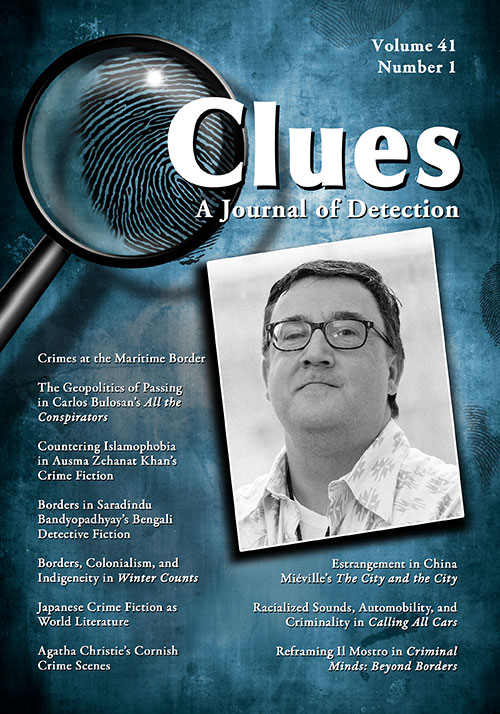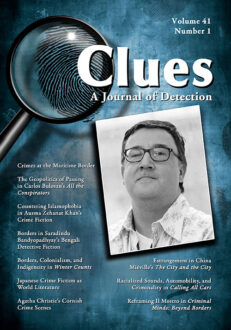Clues: A Journal of Detection, Vol. 41, No. 1 (Spring 2023)
Print Back Issue$30.00
In stock
About the Book
BACK ISSUE
This is a single back issue only. To order a current subscription, or for more information, please visit the journal’s web page at CluesJournal.com. Back issues from earlier volumes of Clues are available for order subject to availability. Also, single issues of the current volume may be ordered one at a time. Individuals may order back issues directly from our online catalog, and the charge for individuals is $30 (excluding postage). Issues from Volume 33 to the present are also available in ebook format on Kindle, Nook and Google Play.
The charge for single issues for institutions is $75 per issue (excluding postage). If your institution requires a back issue, please contact us to order at the appropriate rate.
About the Author(s)
Bibliographic Details
Executive Editor Caroline Reitz
Managing Editor Elizabeth Foxwell
Consulting Editor Margaret Kinsman
Format: softcover (7 x 10)
Pages: 149
Bibliographic Info: Index
Copyright Date: 2023
ISSN: 0742-4248
Imprint: McFarland
Table of Contents
Introduction: Detective Fiction and Borders
manina jones 5
The guest editor of this theme issue of Clues provides an overview of the issue, including essays on Saradindu Bandyopadhyay, Carlos Bulosan, Agatha Christie, Calling All Cars, Criminal Minds: Beyond Borders, Japanese crime fiction, Ausma Zehanat Khan, Henning Mankell, China Miéville, Miguel Pajares, and David Heska Wanbli Weiden.
Crimes at the Maritime Border: Miguel Pajares’s Aguas de venganza [Waters of Revenge]
silvia ruzzi 13
This essay analyzes Miguel Pajares’s Aguas de venganza [Waters of Revenge, 2016], delving into the representations of the Mediterranean Sea as a constructed lawless maritime border where crimes are unpunished; revenge occurs; and official explanations of border casualties interact with a narrative of border crimes, public negligence, and injustice.
Policing Mobilities and Boundaries: A Study of Henning Mankell’s The Dogs of Riga and Firewall
aratrika mandal and somdatta bhattacharya 28
This article examines the representation of racism and immigration and the ways they transform borderline and bordered space into criminal space in two popular Swedish crime novels by Henning Mankell. In Mankell’s Firewall and Dogs of Riga, negotiations between individuals and borders realize the interaction between state apparatuses and technology, potentially destabilizing the physical and the virtual border.
The Geopolitics of Passing in Carlos Bulosan’s All the Conspirators
sydney van to 39
Carlos Bulosan’s mid–twentieth-century noir novella All the Conspirators stages a conflict between guerrillas and collaborators in the postwar Philippines, illustrating a “geopolitics of passing” that examines the triangulation of borders through acts of racial, ideological, and imperial passing. Through the trope of passing, the transgression and eventual reconstitution of these borders is shown to be an alibi for the expansion of U.S. empire.
Embodied Borders: Countering Islamophobia in Ausma Zehanat Khan’s Crime Fiction
pilar cuder-domínguez 52
This essay draws from critical race and affect studies in addressing how the police officer Esa Khattak in Ausma Zehanat Khan’s crime fiction embodies race and faith differences within the Global North and thus helps bring attention to bear on the rise of anti-Muslim feelings within allegedly plural liberal democracies.
The “Other” Conflicts: Borders in Saradindu Bandyopadhyay’s Bengali Detective Fiction
shreya das 62
The article examines the response of popular Bengali literary works to the Partition of 1947 in India, which brought about a mass migration across the borders of Punjab and Bengal. It focuses on Saradindu Bandyopadhyay’s Byomkesh series, one of the most popular Bengali detective series.
“So long as [the crime] took place on Indian land”: Borders, Colonialism, and Indigeneity in Winter Counts
nicole kenley 74
The exploration of criminally instantiated settler colonial borders by David Heska Wanbli Weiden in Winter Counts includes the lasting repercussions of neglect and stigmatization that perpetuate ongoing crime in the Lakota community. Weiden uses detective fiction’s generic conventions of resolution and restoration to offer the dissolution of settler colonial borders as the crime’s true solution.
Japanese Crime Fiction as World Literature
lola sundin 84
This article explores the development of Japanese crime fiction through the translation and circulation of international crime fiction as world literature. It also explores the circulation of modern Japanese crime fiction, demonstrating that the genre has achieved more widespread readership (and hence status as “world literature”) through translations into less-translated languages.
“No Picturesque Village is Safe”: Agatha Christie’s Cornish Crime Scenes in “The Blood-Stained Pavement” and “Ingots of Gold”
charlotte beyer 95
This article explores Agatha Christie’s representations of Cornwall and Cornish crime scenes in two crime short stories, “The Blood-Stained Pavement” (1928) and “Ingots of Gold” (1928). The author argues that Christie looks behind popular cultural representations of Cornwall, uncovering dark tourism, heritage crime, histories of oppression, misogynist violence, and murder.
Securing and Crossing Borders: Estrangement in China Miéville’s The City and the City
mona kammer 106
This essay discusses the setting of the detective novel The City and the City that estranges its genre by its depiction of borders. Borders are perceived in a sociological sense not only as territorial but also as mental constructions. The investigator functions as a keeper of the law but also a (literal and figurative) border-crosser.
Transmitting Aural Borders: Racialized Sounds, Automobility, and Criminality in Calling All Cars
benjamin williams 117
The 1930s radio broadcast Calling All Cars subverted the genre of hard-boiled detective fiction to dramatically tell stories of “true” local crime committed in Southern California. Each episode was filtered through the police to sonically discipline its local listeners, promote citizen surveillance, and constitute an aural border that criminalized racialized populations.
Reframing Il Mostro in Criminal Minds: Beyond Borders: American Killers, Italian Monsters, and the Transnational Imagination
francesca borrione 128
This essay discusses two American obsessions—xenophobia and serial killers—as displayed in the episode “Il mostro” from the CBS program Criminal Minds: Beyond Borders (2017). By placing two murder mysteries—one American, one Italian—in conversation, “Il mostro” appeals to the transnational imagination while reinforcing collective anxieties about the fear of the other.
REVIEWS
Jesper Gulddal, Stewart King, and Alistair Rolls, Eds. The Cambridge Companion to World Crime Fiction
anissa m. graham 139
Desirée Prideaux. Sleuthing Miss Marple: Gender, Genre, and Agency in Agatha Christie’s Crime Fiction
rachel schaffer 140
Debayan Deb Barman, ed. Critical Essays on English and Bengali Detective Fiction
diane m. calhoun-french 142
Stacy Gillis and Gunnthorunn Guðmundsdóttir, Eds. Noir in the North: Genre, Politics and Place
clare rolens 143
Sarah Hagelin and Gillian Silverman. The New Female Antihero: The Disruptive Women of Twenty-first-Century US Television
caroline reitz 145
Call for Papers, BIPOC Female Detectives 147
Author Guidelines are on page 149.
Book Reviews & Awards
- “Clues is a must-have for readers and writers of crime fiction. Scholarly, thought-provoking, wide-ranging in its topics, Clues covers the crime and thriller map.”—Sara Paretsky
- “A. Conan Doyle, notoriously resentful of Sherlock Holmes’s success, liked to scorn ‘police romances’ as less significant and worthy of his talents than his other literary work. If he could have read Clues, the thinking mystery reader’s journal, he would surely have felt differently—and learned much he never realized himself about even his own landmark contribution to the genre, from which so much else by others has flowed.”—Jon Lellenberg, U.S. agent for the Arthur Conan Doyle estate
- “I love reading Clues. Every issue provides thought-provoking, well-researched articles. The variety and scope of the material found in Clues makes an unparalleled, ongoing contribution to our understanding of the role of crime fiction in our culture, and the genre’s reflection of its time and society.”—Jan Burke, Edgar-winning author of The Messenger (2009)
- “Clues is an important journal. It carries the torch of tradition that is the backbone of detective fiction. It goes below the surface and gets to the heart of what makes the genre so fascinating and valid today”—Michael Connelly, author of the Harry Bosch novels, including The Overlook (2007)
- “for erudite and fascinating truths about mysteries, follow the clues to Clues, the scholarly journal that is an essential resource for every serious student of the mystery”—Carolyn Hart, author of Death Walked In (2008)
- “with scholarship ranging from Poe to Peters, nothing beats Clues”—Joan Hess, author of Mummy Dearest (2008).





